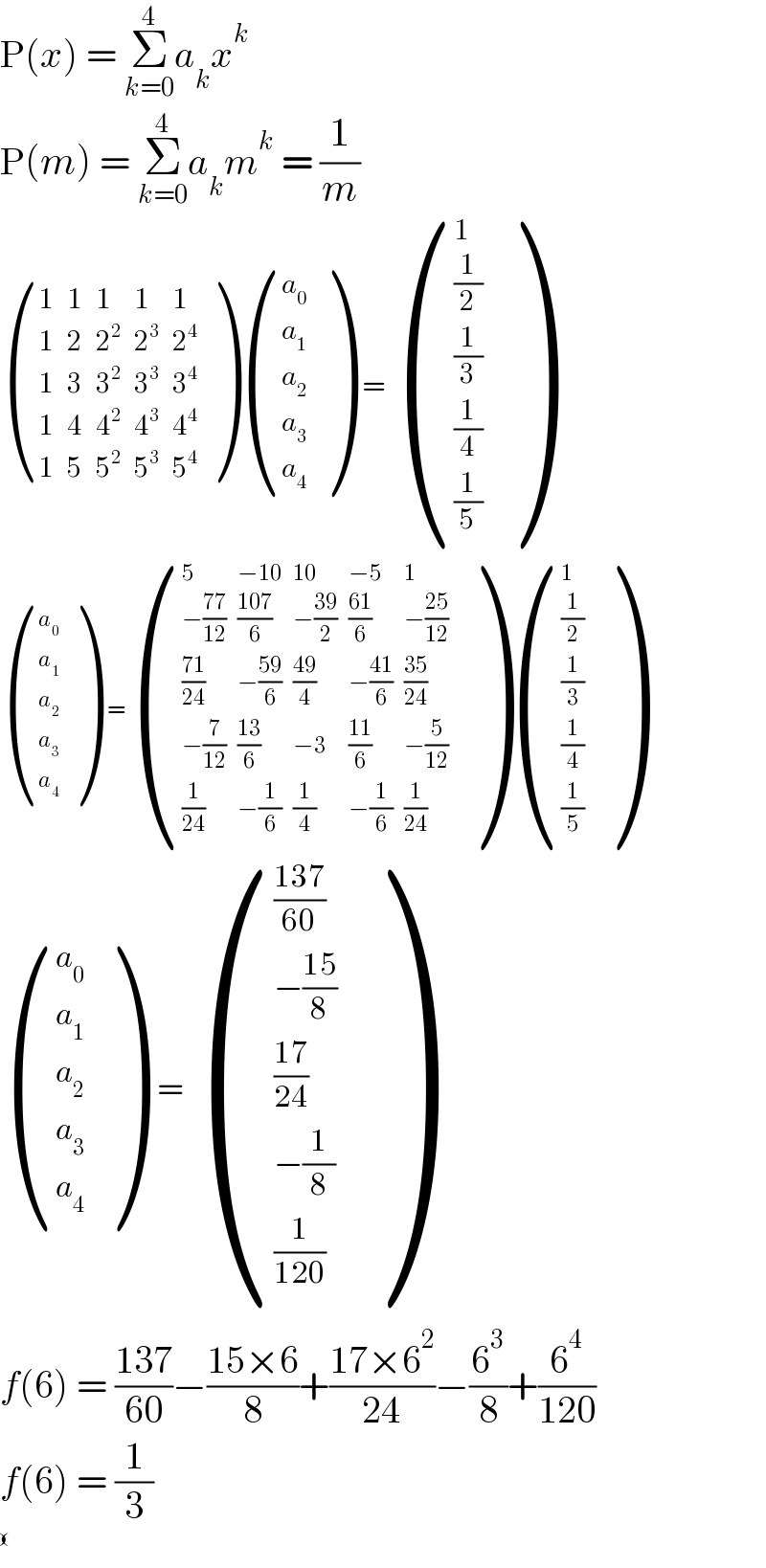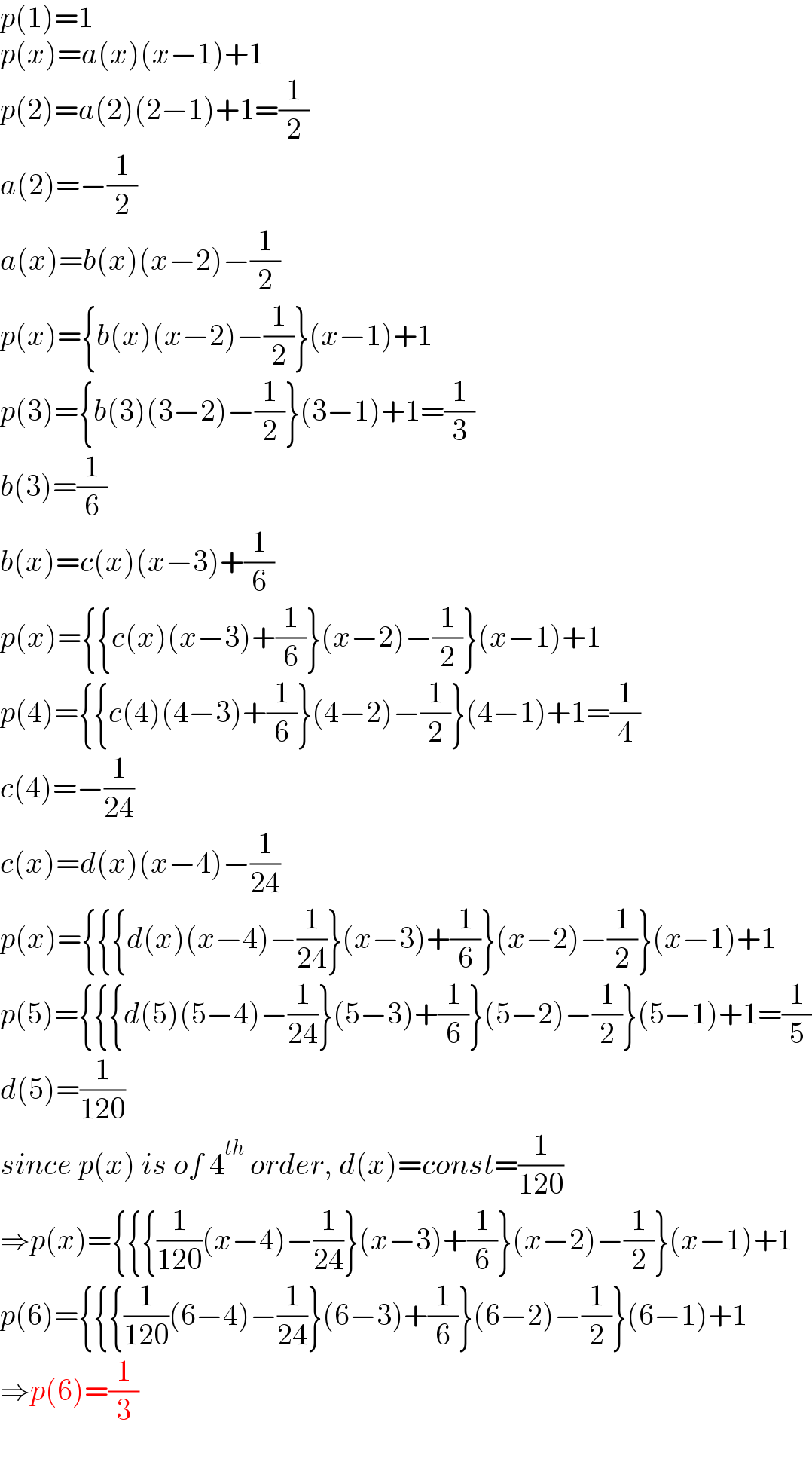Question Number 144170 by mathdanisur last updated on 22/Jun/21

Answered by Olaf_Thorendsen last updated on 22/Jun/21

$$\mathrm{P}\left({x}\right)\:=\:\underset{{k}=\mathrm{0}} {\overset{\mathrm{4}} {\sum}}{a}_{{k}} {x}^{{k}} \\ $$$$\mathrm{P}\left({m}\right)\:=\:\underset{{k}=\mathrm{0}} {\overset{\mathrm{4}} {\sum}}{a}_{{k}} {m}^{{k}} \:=\:\frac{\mathrm{1}}{{m}} \\ $$$$\begin{pmatrix}{\mathrm{1}}&{\mathrm{1}}&{\mathrm{1}}&{\mathrm{1}}&{\mathrm{1}}\\{\mathrm{1}}&{\mathrm{2}}&{\mathrm{2}^{\mathrm{2}} }&{\mathrm{2}^{\mathrm{3}} }&{\mathrm{2}^{\mathrm{4}} }\\{\mathrm{1}}&{\mathrm{3}}&{\mathrm{3}^{\mathrm{2}} }&{\mathrm{3}^{\mathrm{3}} }&{\mathrm{3}^{\mathrm{4}} }\\{\mathrm{1}}&{\mathrm{4}}&{\mathrm{4}^{\mathrm{2}} }&{\mathrm{4}^{\mathrm{3}} }&{\mathrm{4}^{\mathrm{4}} }\\{\mathrm{1}}&{\mathrm{5}}&{\mathrm{5}^{\mathrm{2}} }&{\mathrm{5}^{\mathrm{3}} }&{\mathrm{5}^{\mathrm{4}} }\end{pmatrix}\begin{pmatrix}{{a}_{\mathrm{0}} }\\{{a}_{\mathrm{1}} }\\{{a}_{\mathrm{2}} }\\{{a}_{\mathrm{3}} }\\{{a}_{\mathrm{4}} }\end{pmatrix}\:\:=\:\begin{pmatrix}{\mathrm{1}}\\{\frac{\mathrm{1}}{\mathrm{2}}}\\{\frac{\mathrm{1}}{\mathrm{3}}}\\{\frac{\mathrm{1}}{\mathrm{4}}}\\{\frac{\mathrm{1}}{\mathrm{5}}}\end{pmatrix} \\ $$$$\begin{pmatrix}{{a}_{\mathrm{0}} }\\{{a}_{\mathrm{1}} }\\{{a}_{\mathrm{2}} }\\{{a}_{\mathrm{3}} }\\{{a}_{\mathrm{4}} }\end{pmatrix}\:\:=\begin{pmatrix}{\mathrm{5}}&{−\mathrm{10}}&{\mathrm{10}}&{−\mathrm{5}}&{\mathrm{1}}\\{−\frac{\mathrm{77}}{\mathrm{12}}}&{\frac{\mathrm{107}}{\mathrm{6}}}&{−\frac{\mathrm{39}}{\mathrm{2}}}&{\frac{\mathrm{61}}{\mathrm{6}}}&{−\frac{\mathrm{25}}{\mathrm{12}}}\\{\frac{\mathrm{71}}{\mathrm{24}}}&{−\frac{\mathrm{59}}{\mathrm{6}}}&{\frac{\mathrm{49}}{\mathrm{4}}}&{−\frac{\mathrm{41}}{\mathrm{6}}}&{\frac{\mathrm{35}}{\mathrm{24}}}\\{−\frac{\mathrm{7}}{\mathrm{12}}}&{\frac{\mathrm{13}}{\mathrm{6}}}&{−\mathrm{3}}&{\frac{\mathrm{11}}{\mathrm{6}}}&{−\frac{\mathrm{5}}{\mathrm{12}}}\\{\frac{\mathrm{1}}{\mathrm{24}}}&{−\frac{\mathrm{1}}{\mathrm{6}}}&{\frac{\mathrm{1}}{\mathrm{4}}}&{−\frac{\mathrm{1}}{\mathrm{6}}}&{\frac{\mathrm{1}}{\mathrm{24}}}\end{pmatrix}\begin{pmatrix}{\mathrm{1}}\\{\frac{\mathrm{1}}{\mathrm{2}}}\\{\frac{\mathrm{1}}{\mathrm{3}}}\\{\frac{\mathrm{1}}{\mathrm{4}}}\\{\frac{\mathrm{1}}{\mathrm{5}}}\end{pmatrix}\:\: \\ $$$$\begin{pmatrix}{{a}_{\mathrm{0}} }\\{{a}_{\mathrm{1}} }\\{{a}_{\mathrm{2}} }\\{{a}_{\mathrm{3}} }\\{{a}_{\mathrm{4}} }\end{pmatrix}\:\:\:=\:\begin{pmatrix}{\frac{\mathrm{137}}{\mathrm{60}}}\\{−\frac{\mathrm{15}}{\mathrm{8}}}\\{\frac{\mathrm{17}}{\mathrm{24}}}\\{−\frac{\mathrm{1}}{\mathrm{8}}}\\{\frac{\mathrm{1}}{\mathrm{120}}}\end{pmatrix}\:\: \\ $$$${f}\left(\mathrm{6}\right)\:=\:\frac{\mathrm{137}}{\mathrm{60}}−\frac{\mathrm{15}×\mathrm{6}}{\mathrm{8}}+\frac{\mathrm{17}×\mathrm{6}^{\mathrm{2}} }{\mathrm{24}}−\frac{\mathrm{6}^{\mathrm{3}} }{\mathrm{8}}+\frac{\mathrm{6}^{\mathrm{4}} }{\mathrm{120}} \\ $$$${f}\left(\mathrm{6}\right)\:=\:\frac{\mathrm{1}}{\mathrm{3}} \\ $$$$\begin{pmatrix}\\\end{pmatrix} \\ $$
Commented by mathdanisur last updated on 22/Jun/21

$${alot}\:{perfect}\:{thank}\:{you}\:{Sir} \\ $$
Answered by mr W last updated on 22/Jun/21

$${p}\left(\mathrm{1}\right)=\mathrm{1} \\ $$$${p}\left({x}\right)={a}\left({x}\right)\left({x}−\mathrm{1}\right)+\mathrm{1} \\ $$$${p}\left(\mathrm{2}\right)={a}\left(\mathrm{2}\right)\left(\mathrm{2}−\mathrm{1}\right)+\mathrm{1}=\frac{\mathrm{1}}{\mathrm{2}} \\ $$$${a}\left(\mathrm{2}\right)=−\frac{\mathrm{1}}{\mathrm{2}} \\ $$$${a}\left({x}\right)={b}\left({x}\right)\left({x}−\mathrm{2}\right)−\frac{\mathrm{1}}{\mathrm{2}} \\ $$$${p}\left({x}\right)=\left\{{b}\left({x}\right)\left({x}−\mathrm{2}\right)−\frac{\mathrm{1}}{\mathrm{2}}\right\}\left({x}−\mathrm{1}\right)+\mathrm{1} \\ $$$${p}\left(\mathrm{3}\right)=\left\{{b}\left(\mathrm{3}\right)\left(\mathrm{3}−\mathrm{2}\right)−\frac{\mathrm{1}}{\mathrm{2}}\right\}\left(\mathrm{3}−\mathrm{1}\right)+\mathrm{1}=\frac{\mathrm{1}}{\mathrm{3}} \\ $$$${b}\left(\mathrm{3}\right)=\frac{\mathrm{1}}{\mathrm{6}} \\ $$$${b}\left({x}\right)={c}\left({x}\right)\left({x}−\mathrm{3}\right)+\frac{\mathrm{1}}{\mathrm{6}} \\ $$$${p}\left({x}\right)=\left\{\left\{{c}\left({x}\right)\left({x}−\mathrm{3}\right)+\frac{\mathrm{1}}{\mathrm{6}}\right\}\left({x}−\mathrm{2}\right)−\frac{\mathrm{1}}{\mathrm{2}}\right\}\left({x}−\mathrm{1}\right)+\mathrm{1} \\ $$$${p}\left(\mathrm{4}\right)=\left\{\left\{{c}\left(\mathrm{4}\right)\left(\mathrm{4}−\mathrm{3}\right)+\frac{\mathrm{1}}{\mathrm{6}}\right\}\left(\mathrm{4}−\mathrm{2}\right)−\frac{\mathrm{1}}{\mathrm{2}}\right\}\left(\mathrm{4}−\mathrm{1}\right)+\mathrm{1}=\frac{\mathrm{1}}{\mathrm{4}} \\ $$$${c}\left(\mathrm{4}\right)=−\frac{\mathrm{1}}{\mathrm{24}} \\ $$$${c}\left({x}\right)={d}\left({x}\right)\left({x}−\mathrm{4}\right)−\frac{\mathrm{1}}{\mathrm{24}} \\ $$$${p}\left({x}\right)=\left\{\left\{\left\{{d}\left({x}\right)\left({x}−\mathrm{4}\right)−\frac{\mathrm{1}}{\mathrm{24}}\right\}\left({x}−\mathrm{3}\right)+\frac{\mathrm{1}}{\mathrm{6}}\right\}\left({x}−\mathrm{2}\right)−\frac{\mathrm{1}}{\mathrm{2}}\right\}\left({x}−\mathrm{1}\right)+\mathrm{1} \\ $$$${p}\left(\mathrm{5}\right)=\left\{\left\{\left\{{d}\left(\mathrm{5}\right)\left(\mathrm{5}−\mathrm{4}\right)−\frac{\mathrm{1}}{\mathrm{24}}\right\}\left(\mathrm{5}−\mathrm{3}\right)+\frac{\mathrm{1}}{\mathrm{6}}\right\}\left(\mathrm{5}−\mathrm{2}\right)−\frac{\mathrm{1}}{\mathrm{2}}\right\}\left(\mathrm{5}−\mathrm{1}\right)+\mathrm{1}=\frac{\mathrm{1}}{\mathrm{5}} \\ $$$${d}\left(\mathrm{5}\right)=\frac{\mathrm{1}}{\mathrm{120}} \\ $$$${since}\:{p}\left({x}\right)\:{is}\:{of}\:\mathrm{4}^{{th}} \:{order},\:{d}\left({x}\right)={const}=\frac{\mathrm{1}}{\mathrm{120}} \\ $$$$\Rightarrow{p}\left({x}\right)=\left\{\left\{\left\{\frac{\mathrm{1}}{\mathrm{120}}\left({x}−\mathrm{4}\right)−\frac{\mathrm{1}}{\mathrm{24}}\right\}\left({x}−\mathrm{3}\right)+\frac{\mathrm{1}}{\mathrm{6}}\right\}\left({x}−\mathrm{2}\right)−\frac{\mathrm{1}}{\mathrm{2}}\right\}\left({x}−\mathrm{1}\right)+\mathrm{1} \\ $$$${p}\left(\mathrm{6}\right)=\left\{\left\{\left\{\frac{\mathrm{1}}{\mathrm{120}}\left(\mathrm{6}−\mathrm{4}\right)−\frac{\mathrm{1}}{\mathrm{24}}\right\}\left(\mathrm{6}−\mathrm{3}\right)+\frac{\mathrm{1}}{\mathrm{6}}\right\}\left(\mathrm{6}−\mathrm{2}\right)−\frac{\mathrm{1}}{\mathrm{2}}\right\}\left(\mathrm{6}−\mathrm{1}\right)+\mathrm{1} \\ $$$$\Rightarrow{p}\left(\mathrm{6}\right)=\frac{\mathrm{1}}{\mathrm{3}} \\ $$
Commented by mathdanisur last updated on 22/Jun/21

$${alot}\:{perfect}\:{thanks}\:{Sir} \\ $$
